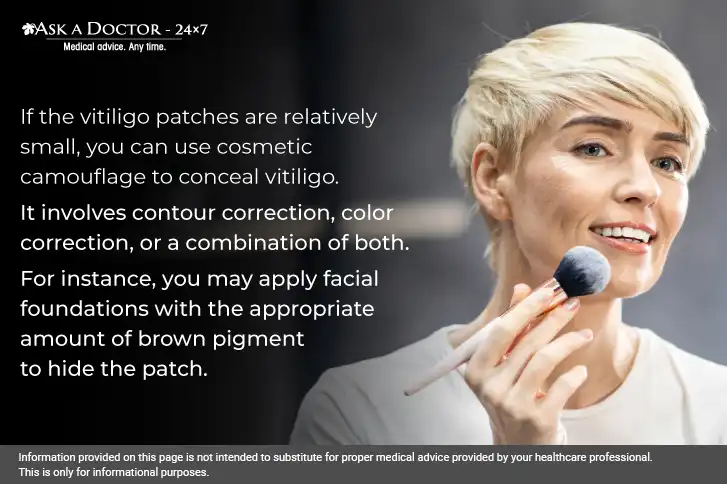Everything You Need To Know About Vitiligo
Vitiligo is a chronic (long-lasting) autoimmune condition that results in regions of skin losing their color and pigment. It is a multifactorial disease initiated by environmental, genetic, and immune factors. The skin turns a milky-white color when melanocytes (pigment-producing cells) are attacked and destroyed by your body’s immune system. As a result, there are not enough working melanocytes to produce skin pigment, melanin in your skin. This causes white patches to develop on your skin or hair.
Vitiligo can affect any part of the skin but usually involves the hands, face, neck, and wrinkles in the skin. Vitiligo varies in appearance, causing a few pale spots on certain people while in others there may be a more extensive loss of color. Let’s do a deep dive to understand this skin condition that isn’t dangerous but can affect self-esteem and make people feel insecure about their appearance.
Symptoms of Vitiligo
Each person experiences vitiligo differently. For instance, some people might simply have a few small white dots that don't grow much bigger, while others might have larger white patches that connect and cover larger sections of skin. The common symptoms of vitiligo are:
The development of flat, lighter-colored spots or patches on the skin is a defining sign of vitiligo. The first visible white spot is the result of a minor injury or sunburn. It could seem like a plain patch at first, a shade paler than the surrounding skin, but with time, it will get paler and paler until it goes white. The patches of vitiligo vary in size and shape. There may be instances when the edges get inflamed, which makes them itchy. Your body may also have patches of silver, grey, or white hair.
But usually, despite being more prone to sunburn, it doesn't result in any pain, inflammation, soreness, or dryness in the skin.
In addition, some people may have thyroid problems, hearing loss, and pigmentation loss in the eyes.
Types of Vitiligo
Depending on the distribution of the patches, dermatologists refer to vitiligo as:
- Localized vitiligo: When you have a few patches or spots that grow in one or more locations on your body.
- Generalized vitiligo: It is the term used to describe vitiligo that results in dispersed patches of color loss on various body parts, usually symmetrical on both sides.
- Non-segmental vitiligo: In non-segmental vitiligo, patches typically develop on both sides of the body, such as both hands and both knees.
- Segmental vitiligo: It is also referred to as unilateral vitiligo which causes loss of skin color on one side or body portion. Segmental vitiligo usually stabilizes, or the color loss ceases, after six to twelve months. Most persons with segmental vitiligo don't get any new patches or spots once it stops.
Treatment of Vitiligo

Usually, vitiligo starts off as a few tiny, lighter spots on the skin. These patches could enlarge or remain the same size for years. Skin can also develop new patches. Thus to check its spread, a dermatologist should be consulted as no one treatment works best for vitiligo. Your dermatologist would determine the best treatment that includes:
1) Stay Protected from the Sun
Vitiligo causes the skin to burn easily because the skin lacks pigment to shield it from the sun's rays. Additionally, a severe sunburn might make vitiligo worse. Therefore a vitiligo patient must stay protected from the sunrays as much as possible. To shield your skin from the sun, physicians may advise you to:
- Look for shade or carry an umbrella, whenever you are bound to face the sun.
- Make sure to always wear sun-protective apparel.
- Use sunscreen with an SPF of 30 or higher that provides broad-spectrum protection and water resistance.
- Try to remain steer clear of tanning.
2) Other Topical Treatment
When vitiligo affects small regions of the skin, topical steroids, topical calcineurin inhibitors, or topical Janus kinase (JAK) inhibitors are recommended to treat the underlying inflammation that can occasionally help restore pigment.
3) Light Therapy or Phototherapy
It is the treatment of choice to help return color to your skin. Your dermatologist would treat depigmented areas of skin by exposing it to special wavelengths of light like ultraviolet A light (PUVA) or ultraviolet B (UVB) lights or medical-grade lasers for a short amount of time. To see improvements in your skin, multiple light therapy sessions may be necessary.
4) Depigmentation or Bleaching Therapy
The goal of depigmentation therapy is to match the color of the vitiligo-affected portions of your skin to your normal skin tone. Monobenzone is a medication used in depigmentation therapy. This drug can be applied to areas of your skin that are pigmented. This will cause the parts of your skin that have vitiligo to turn white.
Conclusion
Vitiligo cannot be prevented. If you notice any light-colored patches or spots on your skin, consult a board-certified dermatologist. Treatment for vitiligo is typically more effective if it begins earlier, as it is more challenging to treat if goes untreated for years. Also, vitiligo patients frequently experience mental health issues that impair their self-worth, and confidence, as well as their relationships with friends and family. If this occurs, then your healthcare provider might advise you to join a support group or schedule a counseling session for mental well-being.
If you have any questions regarding vitiligo or other white patches on your skin, you can check with our dermatologist at Ask a Doctor, 24x7.
Recently Answered Queries Related to Vitiligo
- Can Vitiligo Be Confirmed With Wood's Lamp Test?
- Does Vitiligo Have Any Associated Medical Problems?
- Can Dicaris - Adults Cure Vitiligo?
- What Is The Permanent Treatment For Vitiligo?
- Is Depigmentation On The Inner Side Of The Lips A Cause For Concern?
- What Causes A White Patch Under The Eye?
- Suggest Remedies For Vitiligo
- Are Skin Rash, Swollen Face Glands And Sore Eyes The Side Effects Of Imuran?
- Is There An Alternative To Pentasa And Flagyl?
Disclaimer: Information provided on this page is not intended to substitute for proper medical advice provided by your healthcare professional. This is only for informational purposes.
Ask a Specialist
Recent Questions


